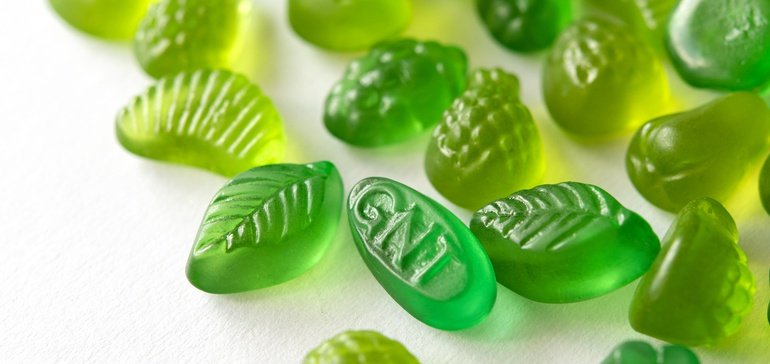GNT debuts green colorings made from spirulina and turmeric

Dive Brief:
- GNT Group has added two green shades made from a blend of blue-green spirulina algae and yellow turmeric to its plant-based Exberry line of natural colors, according to a press release. Shade Lime Green gives food and beverages a yellowish green hue, while Shade Jade Green provides a bluish green.
- The shades are said to be halal, kosher and vegan-friendly and can be used in dairy products such as yogurt and ice cream, and hard- and soft-panned confectionery items like gummies and jellies. They are currently offered in liquid form and will be available as a powder toward the end of the year, according to the company.
- As consumer demand for clean-label foods grows, the use of trendy spirulina and turmeric in GNT’s newest green shades shows the potential of plant-based sources for colors.
Dive Insight:
The inspiration behind GNT’s more than 40-year-old Exberry line is “coloring food with food.” The company has developed reds from vegetables and fruits such as radishes, sweet potato, hibiscus and berries, and yellows from carrots, in liquid and powder forms.
In 2019, The Netherlands-based company introduced a blue food coloring made from spirulina. The one-cell organism has been a popular ingredient in both natural food colorings and even plant-based protein applications. The FDA first gave approval for spirulina as a food coloring for confections in 2013 in response to Mars’ petition to use the algae as a base for a natural blue for M&Ms (although the candy giant’s focus has since shifted to the potential of red cabbage).
GNT has developed its greens from a mix of spirulina and a yellow plant pigment. The use of turmeric in the two newest shades highlights the power of spices to add vibrancy. In 2020, GNT debuted a brilliant orange based on carrot and paprika. Turmeric has most recently grabbed interest for its functional properties; curcumin, a chemical in the spice, has offered potential for relieving osteoarthritis and rheumatism symptoms, and boosting memory and mood. It’s also what gives turmeric its bright yellow color.
When it comes to natural colors, that vibrancy is key. The history of food product development is filled with manufacturers’ aborted attempts at swapping out artificial ingredients in products such as candy and cereal with natural alternatives, but the dull results have left consumers unimpressed. This is despite the fact that many people prefer natural hues out of an interest in clean eating. A recent survey by the International Food Information Council found that 35% of consumers look for natural colors in their food and beverages.
Natural colors also have faced issues with stability depending on the food or beverage application, and the end product’s exposure to different pH values, light and heat. The curcumin in turmeric, for example, is sensitive to light and heat. Acids can affect the vibrancy of blues, greens and violets, and a lower pH is important for bright reds and pinks.
These challenges, however, are not likely to distract ingredient manufacturers such as GNT, Sensient, Archer Daniels Midland, Kalsec and Oterra (formerly known as Chr. Hansen Natural Colors) from a segment with tremendous growth potential. Meticulous Market Research projects an 8.4% compound annual growth rate for natural colors from 2019 to 2027, to hit $3.2 billion in global sales.
Source: fooddive.com

